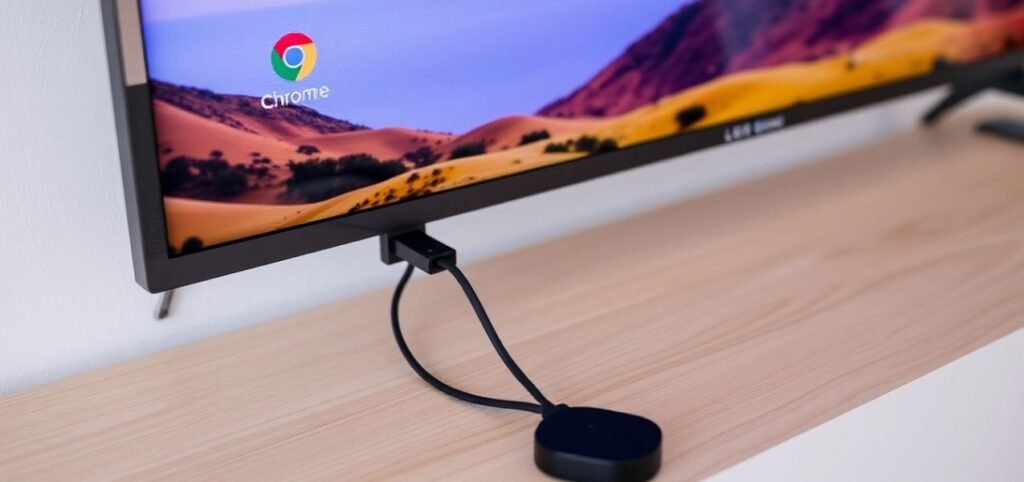Chromecast is a popular streaming device developed by Google that allows users to stream content from their devices, like phones or tablets, to a television screen. With Chromecast, you can cast movies, TV shows, music, photos, and even games directly to your TV, transforming a basic screen into a smart one. This simple device connects to your TV via an HDMI port, bringing streaming services, internet content, and multimedia to a big screen.

What is Chromecast?
Chromecast is a small, compact device that connects to your TV’s HDMI port and lets you stream media content from your phone, tablet, laptop, or other device onto your TV. Unlike traditional cable or satellite boxes, it doesn’t have channels or built-in apps. Instead, it relies on casting, where you “cast” content from your device (phone, tablet, or laptop) to your TV screen.
Main Features:
- Streaming Content: Allows streaming from popular platforms like Netflix, YouTube, Disney+, Spotify, and more.
- Multi-Device Support: Works with both Android and iOS devices, as well as computers and laptops.
- Affordable Option: Priced lower than many other streaming devices, making it a budget-friendly choice for streaming.
How Does Chromecast Work?
It works by receiving content from a separate device using a technology called casting. Here’s a step-by-step breakdown of how it functions:
1. Connecting to the TV
First, plug Chromecast into an HDMI port on your TV. Once connected, switch the TV to the correct HDMI input channel. Then, It is powered either through a USB port on your TV or a wall adapter, depending on your preference and TV model.
2. Setting Up Chromecast with Google Home
To set it up, you need to have the Google Home app installed on your smartphone or tablet. Once the app is installed, follow these steps:
- Open the Google Home app and connect Chromecast to the Wi-Fi network.
- The app will guide you through setup instructions, which include naming your Chromecast and linking it to your Google account.
After setup, it is ready to cast content from your mobile device or computer directly to your TV.
3. Casting Content from Your Device to the TV
Once your Chromecast is set up, it’s easy to start casting. For example, if you’re watching a video on YouTube:
- Open the YouTube app on your phone.
- Tap the “cast” icon (a small rectangle with Wi-Fi lines in one corner).
- Select your Chromecast device from the list that appears.
Once connected, the content will appear on your TV screen. You can use your phone as a remote to pause, play, rewind, or adjust volume.
4. Using Google Assistant with Chromecast
Newer versions of It support Google Assistant, allowing you to control it hands-free using voice commands. If you have a Google Assistant-enabled speaker (like Google Nest), you can use voice commands such as, “Hey Google, play The Crown on Netflix on Chromecast.” Google Assistant will then stream the content to your TV via it.
Different Types of Chromecast
- Chromecast (3rd Generation): This basic version allows you to cast content in Full HD (1080p) from your device.
- Chromecast Ultra: This model supports 4K Ultra HD and HDR streaming, making it ideal for high-quality streaming.
- Chromecast with Google TV: This version comes with a remote and has Google TV built-in, which is a major upgrade. It allows users to navigate content directly on the TV screen, making it more of a standalone streaming device than previous versions.
Benefits of It:
It offers several advantages that make it a favorite streaming option for many users:
- Affordable and Compact: It is small, easy to set up, and generally more affordable than other streaming devices.
- Easy to Use: The casting process is intuitive, especially for those already familiar with using apps on their mobile devices.
- Wide Compatibility: Works with both Android and iOS devices, making it versatile for families or households with a mix of devices.
- No Need for Extra Remote: With most Chromecast models, you don’t need a separate remote, as you can control everything from your phone.
Limitations of It:
Despite its convenience, It has a few limitations:
- Requires a Separate Device: Unlike some other streaming devices, It requires a phone, tablet, or computer to cast content.
- Depends on Wi-Fi Quality: Since Chromecast relies on Wi-Fi, the quality of streaming can be impacted if the Wi-Fi signal is weak or unstable.
- No Built-in Apps in Basic Models: Older models don’t have a dedicated interface, so you can’t browse for content directly on the TV.
Conclusion
Chromecast is an efficient, affordable way to stream content from your devices to your TV, transforming it into a smart screen. By casting from apps like YouTube, Netflix, and Spotify, it brings streaming to life on the big screen without the need for a cable connection or extra remotes. With newer models like Chromecast with Google TV, users can enjoy an even smoother experience with direct access to apps, 4K streaming, and a remote for convenience.
It is a great solution for anyone looking to bring their favorite streaming content to the big screen without breaking the bank. Whether you’re a binge-watcher, music enthusiast, or gamer, it adds more possibilities to your entertainment setup.

Pingback: Amazing Amazon Fire TV Stick: How to Set Up 10 Steps Simple Guide - Tech Passion
Pingback: How to Connect Android Phone to Chromecast: Aware - Tech Passion